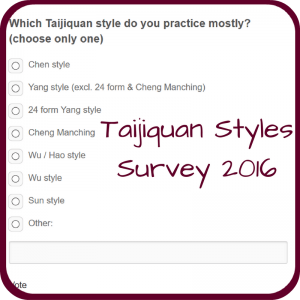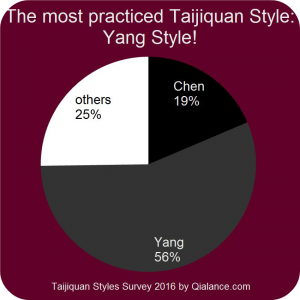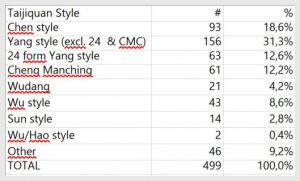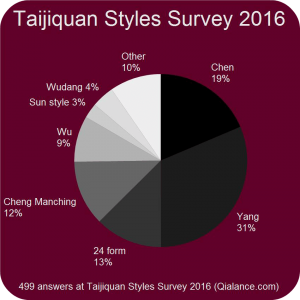In fall 2016 I run a survey on which Tai Chi style is the most popular. I was just curious what the result would be. There are people who say that Yang style is the most popular style and 24 form the most practiced form. Well, I just wanted to really know some numbers.
So I started the survey on October 7th and it was open until beginning of November. I talked about the survey on this blog, in my newsletter, in different Facebook groups and some other bloggers shared the survey, too.
In total I got 499 answers from all over the world! And I just want to say a BIG THANK YOU to everyone who participated and shared. I think that is just terrific that the Internet gives us the opportunity to connect so easily.
And of course I want to share the results with you. Let’s start with an overview:
So overall, Yang style is the most practiced Tai Chi style in the world. I guess that’s not really a surprise, however I find it quite strange that “others” is actually more than Chen!
Let’s have a more detailed look at the results:
Or if you prefer a visual:
And these are my personal key findings from this survey:
- I always thought that Chen style Tai Chi would be much stronger, as it is the original style. Now it seems that 24 form and Cheng Manching form are actually catching up in popularity! If you count Yang style Tai Chi + 24 form + Cheng Manching, that’s more than 50% of Taijiquan practitioners!
- And then let’s talk about the Wu/Hao Style: less than 1% said that they practice it! That’s really not a lot, especially as the Wu/Hao style until now was considered one of the “main” styles.
- On the other side, Wudang Taijiquan seems to be getting bigger! I did not ask for it, but as 4% mentioned it (more than Sun style!), I decided to extract it from the “others” section.
And if you are curious what else is in the “other” section, this is a large list of all the “others” mentioned from the Tai Chi style survey participants:
- Chang Style
- Chen Ming Style
- Chen Pan Ling
- Combined 42
- Dong / Tung Style
- Five Steps Tai Chi (Wuxing Taijiquan)
- Free Style
- Fu Style
- Gu Style
- Guang Ping Yang
- Feng Hun Yuan
- Huleijia
- Hunyuan
- IWUF Competition form
- Khor Style
- Kun Lun Tai Chi
- Lee Style
- Li Style
- Mao
- Mixed
- Other
- Qi Gong
- Shayuquan
- Southern Praying Mantis, Bagua, Qi Gong
- Taoist
- Teh Nei Nia Chuan
- Wahnam
- Xiong Style
- My personal thoughts on this list: It’s quite a wild mix! But obviously everyone wanted to share which type of Taijiquan they practice. I just decided to leave them all in the survey.
Now what to you think about the result of this Taijiquan styles survey? Is Chen style seriously threatened by the Yang dominance? Will smaller styles like Wu/Hao or Sun be extinguished soon? And what about the future of Wudang in the Taijiquan family?
Let’s discuss!
Angelika





Hello,
I think the conclusions should be the other way around. Chen style is surprisingly strong, considering it was only practised in Chen village a few decades ago (See C. Despeux ). Yang supremacy (was 85%, possibly more 20 years ago) is threatened by other styles, and notably Chen style.
Why is that? The Yang (was it them?) made their taichi look too much like 3rd age gymnastics when it can be a lot of fun for younger people as well. Hence the success of Chen or Fu for those very serious at it, but also Wudang who have done very good packaging of their forms, adding a little Hsing-i or pakua flavor to the practice. Sun and Hao style lack experts outside China and can not thrive…
Also note that Chen style does structure what is called Taiji today. In Hongkong, I learned two styles outside Chen heritage (Henan 13 harmonies and Shen Long dragon spririt) which people say are taichi but my teacher advises against the use of this word and keep ‘mian quan’ instead (loose boxing). That is because of techniques and structures not fully compliant to Chen structure. Wudang would probably be in that category but funny enough, mian quan is shortened to mi quan if you don’t hear correctly which means ‘secret’ and this how you get wudang secret taiji, good for spreading out the word…
Ah, interesting to see it that way! I guess I need to do the survey again in 10-20 years!
I”m not surprised that Yang style dominates, but surprised you classified Yang 24 and CMC style as “other.” They are Yang, too.
I haven’t seen your original survey, so what were the variables? …..
Was it self selective?
Did it only apply to Facebook users?
Was it only available to English speakers? What was the breakdown of responses in other languages?
What was the geographic spread of response? How many responses from China? From anglophone countries?
What was the age/sex of respondents?
Did you distinguish between taiji and taijiquan?
I agree, and I did I classify Yang 24 and CMC style as Yang! (Yang + 24 + CMC = 56%!)
Hi John,
this was a very basic survey. You can see the original layout in the first picture. It was only available in English. Every participant could select one of the variables or add “other”.
I wrote about the survey in several Facebook groups, in my newsletter and on my blog. I only asked that one question, so I do not know anything about age, sex or origin.
If you want the long list of answers have a look at the PDF. Just click on the link below and I will send it to you.
Angelika
Interesting but I think you need to bear in mind that the number of responses you received are far to few to establish any true connection between your survey and reality.
Regardless of the fact that I suffer physical handicaps from a history of automobile accidents, I attempted Chen Style classes, with some Yang style blended in. My big mistake! As much as I wanted to practice Chen Style, my limitations were too overwhelming. I may try Wu or Sun Style that isn’t physically demanding.
I surely would have loved to have even more responses! And I hope that if I do this again in a couple of years there will be more people participating.
On the other hand, I had a look at the results every couple of days while it was still running and actually it was pretty stable.
I think one of the big things that Taijiquan (no matter which style) teaches us is to listen to our bodies! So I think it’s really good that you tried Chen and even though it was too demanding, you remain with Taijiquan and just take a different path! And you can surely switch to Chen later!
Very interesting. I have practiced Yang the longest, but also Chen and Wu/Hao. Even though they are different, I don’t always separate them in my mind. My personal practice, I sometimes allow them to mix.
If you ask the Chens who invented Taiji boxing, they will say Chen of course. I don’t claim they are wrong — at least I’m not claiming so in this particular blog comment — but we all know history is written by the winners.
I am not sure if we’ll ever find out who really invented Taijiquan. At least we can all agree that the Chens invented Chen style Taijiquan.
Another thing is that from science we know “multiple discoveries” or “simultaneous inventions”. (see Wikipedia: https://en.wikipedia.org/wiki/Multiple_discovery). Maybe Taijiquan was simple invented in multiple places and multiple people?
Historical context is very important when considering the spread of the different tai chi styles. The yang family were the first to spread the art widely this influencing the creation of the simplified Beijing forms as well as early pioneers to the west such as garda geddes and cheng man ching where as Chen was practiced by relatively few people until the last couple of decades. ( I have books from 30 years ago stating that it was such a shame Chen had nearly died out!). Also different styles have dominated at different times: Li style was massive in the UK in the 70s and 80s but diminished after the death of the late Chee Soo. Political issues have also been an influence in the past – cheng man ching style was unwelcome in main land China due to his nationalist connections, the communists created the 24 step to give tai chi to the people but the subsequent cultural revolution saw the utter repression of the art as well as persecution of Tai Chi and Qigong masters. Tai chi was reclassified as callisthenics! In the post cultural revolution it was re- embraced as a quintessential part of Chinese culture largely due to Deng Xiaoping. A good thing too!
Thank you for your comment! Yes, the importance of different styles depends on living masters, community, politics etc. Let’s see how things change over the next years!
My style is always left out. My Sifu (Kuo Lien Ying) called it “Original Yang.” His student YC Chiang named it “Guang Ping Yang.” It’s fairly widespread in the Bay Area of Northern California and also in New Jersey, propagated by Peter Kwok, and North Carolina, via David Chin. There are also big groups in Portland, Oregon, Cape Cod and Wisconsin. I know of a group in Basel, Sw. too.
Oops! Just found it on your list! First time I have seen it recognized!!!!
Hi Marilyn,
the list actually is all the styles that people mentioned in the survey, so at least one of your fellow practitioners must have participated!
Angelika
I practice Yang, Chen, and Sun. I suspect there are more Sun practitioners than you have listed here. There is a modified Sun version taught for use with Arthritis patients and those who may have mobility problems that could result in unwanted falls. The form is recommended by the Arthritis Foundation here in the United States and in several other countries around the world. It is frequently taught by physical therapists,m recreation specialists, etc. who are not aware of the intricacies and full depth of tai chi. These practitioners may see it as one more therapeutic tool in their collection of exercises. These same folks would also not be likely to subscribe to a tai chi blog either. So you’ve missed a large part of the tai chi community.
I suspect the responses you did receive were from those who are more focused on tai chi. However without knowing the full demographics (location, gender, and other variables) it is hard to validate the meaning of the data you have collected. A properly balanced survey would probably require an academic grant to carry it out.
Basically you have survey results of people who subscribe to your blog. And that’s terrific! You have good content in your blog and I’m happy you have such a large following. (500 answered probably means several hundred or maybe even thousand did not respond to your survey.) I’m glas you offered this survey and compiling the results and sharing was a good thing. Thank you
Hi Joe,
thank you for your feedback! I think I will do the survey again in a couple of years, hopefully more people will take part in it then. But I think this is a great starting point for more survey.
Angelika